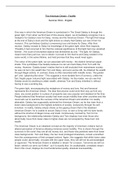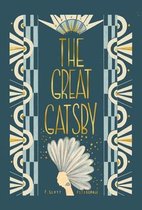The American Dream - Factfile
Summer Work - English
One way in which the American Dream is symbolized in The Great Gatsby is through the
green light. From when we first hear of this elusive object, we immediately recognise it as a
metaphor for Gatsby’s love for Daisy, money and the American Dream. The light first hangs
at the end of Daisy’s dock and the light shines so clearly that Gatsby can see it from his
mansion. This symbolises Gatsby’s unwavering love and desire for Daisy. After their
reunion, Gatsby reveals to Daisy his knowledge of the green light, when Nick inspects,
“Possibly it had occurred to him that the colossal significance of that light had now vanished
forever…His count of enchanted objects had diminished by one.” The light, for Gatbys,
meant more than just love, lust or desire: it proved to him that he and Daisy existed in the
same world, in the same lifetime, and held promise that they would meet again.
The colour of the green light, we can associate with money - the distinct American paper
shade. This symbolises how Gatsby believes he can win back Daisy from Tom with his
money. However, Gatsby doesn’t realise that he is still excluded from mainstream society:
he was not born into wealth like Tom and Daisy, and even worse still, he obtained his wealth
through illegal activity. In contrast, Daisy is often described with metallic tones, “the golden
girl” and, “gleaming like silver.” This suggests a more durable form of currency, unlike the
frail, fragile paper coloured light associated with Gatsby. As the reader, we can see that
Gatsby would do anything to attain wealth, whereas Tom and Daisy inherited it, without
having to see a working day.
The green light, encompassing the metaphors of money and love, first and foremost
represents the American Dream. The idea that anyone could work their way up from any
class, any social position to a place of prosperity was very popular and idealised at the time.
People believed that American society had more social mobility than other countries and this
novel sets out to examine the success of the American Dream and whether it is readily
attainable. Gatsby has supposedly achieved the American Dream, as he has risen from a
lower-class background to the highest echelons of society, exclusively through his self-
invention. In reality, Gatsby simply shows us the gaping chasm that is the idealised
American Dream: he is unable to secure Daisy’s love, or earn a living with his bare hands
without the shortcut of illegal money and trade. Continuously mocked by Tom for his
background, the relationship between Gatsby and Tom displays how even those who
abnormally move from lower-class to higher-class are not accepted by those born into
wealth.
The American Dream is an idealised concept as the majority of American civilians had an
altered perception of America allowing immense social mobility. This is shown through the
survivors in the novel: they are all old money rich, and those who perished were from lower
class backgrounds. Tom and Daisy, the two most privileged characters, remain unscathed
from the consequences of their arrogant actions. Again, this suggests that whilst lower class
people could, abnormally, circulate with the upper class, they will still not be acknowledged
or approved. The American Dream is labelled a ‘dream’ for a reason, “tomorrow we will run
faster, stretch our arms out further”, as it is exactly that. An unattainable, unrealistic dream
that in this novel, displays its most fundamental quality: absolute inaccessibility.





